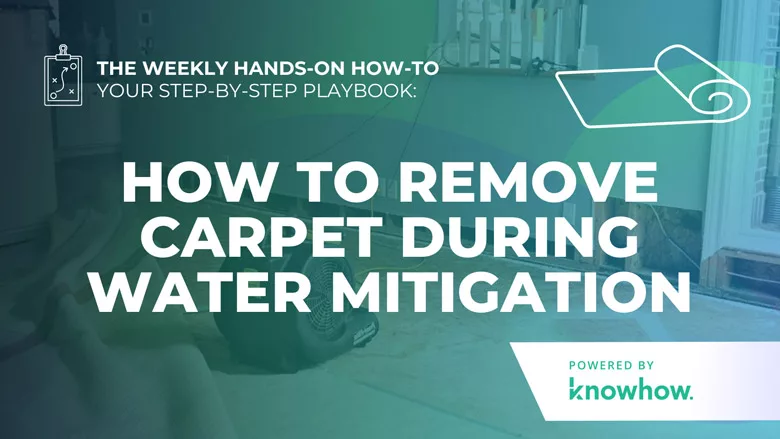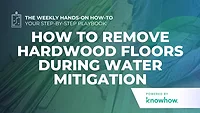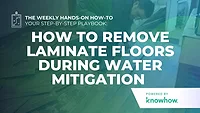Weekly Hands-on How-To powered by KnowHow
How to Remove Carpet During Water Mitigation
A Step-by-Step Guide to Removing Water-Damaged Carpet for Effective Restoration

All images provided by KnowHow.
Whether it’s a burst pipe, storm runoff, or a leaky appliance, water-damaged carpets can quickly become a breeding ground for mold and bacteria. And while saving the carpet might seem tempting, knowing when, and how to remove it is crucial for a successful restoration and a safe, healthy environment.
Carpet removal isn’t just about ripping it out and hauling it away. It’s a step-by-step process that requires careful planning, the right tools, and attention to detail. From assessing the damage to properly disposing of the materials, every stage plays a critical role in preventing further damage to the property and ensuring a smooth restoration process.
In this weekly how-to, powered by KnowHow, we’ll walk you through the process of properly removing water-damaged carpets—from evaluating the need for removal to leaving the area spotless and ready for recovery. Let’s roll up our sleeves and get to work!
Note: This Weekly Hands-On How-To was based on this template in KnowHow’s template library.
Step 1: Assess the Damage to the Carpet
Start by thoroughly inspecting the carpet to understand the extent of the water damage. Look for signs of heavy saturation, mold, or mildew, and take note of any musty odors. This initial evaluation will guide your approach, helping determine whether removal is necessary. If mold is present, proceed cautiously and follow mold remediation protocols to prevent further contamination.
Step 2: Determine When Carpet Removal Is Necessary
To decide whether removal is essential, consider:
- The Source of the Water: Water from contaminated sources (Category 2 or 3) requires immediate removal.
- Duration of Exposure: Carpets wet for over 48 hours are at high risk for mold and bacterial growth.
- Condition of the Carpet: Assess for signs like a musty odor, visible mold, or extensive water seepage into the subfloor.
If any of these factors are present, removing the carpet promptly is crucial to prevent long-term structural damage and health risks.
Step 3: Begin by Removing Furniture from the Affected Area
Clear the workspace by relocating furniture and other items from the affected room. This prevents additional damage to your belongings and gives you unimpeded access to the carpet. Place furniture in a dry area and protect it with plastic sheeting or tarps to keep it safe during the process.

Step 4: Extract Excess Water from the Carpet and Pad
Using a water extractor, remove as much water as possible from the carpet and the padding underneath. This step minimizes the weight of the materials and prepares them for easier handling during removal. Be thorough—excess moisture can lead to mold growth in the subfloor.
Step 5: Cut the Carpet into Manageable Sections
For ease of removal, cut the carpet into smaller, more manageable pieces using a utility knife.
- Start at a Corner: Begin in one corner and work systematically across the room.
- Protect Yourself: Wear gloves and kneepads to reduce strain and avoid injury during the cutting process.
By dividing the carpet into sections, you’ll make the lifting and disposal process safer and more efficient.
Step 6: Pull Up the Cut Sections of Carpet
Working with the manageable sections, carefully pull the carpet up from the floor. Pull slowly to avoid tearing or unnecessary effort. If the carpet is heavily saturated, enlist the help of a partner to lift and carry the sections.

Step 7: Remove the Padding Underneath the Carpet
Once the carpet is out, carefully lift and remove the padding underneath. Wet padding can trap moisture against the subfloor, so ensure it’s completely removed to allow for effective drying.
- Dispose Properly: Bag the padding immediately to avoid contamination or mold spread.
- Inspect the Subfloor: Check for any signs of water damage or mold on the subfloor and treat it as needed before proceeding.
Step 8: Remove the Tack Strips
Use a hammer and flat bar to pry up the tack strips along the edges of the room.
- Work with Caution: Tack strips are sharp and can cause injury. Wear heavy-duty gloves while handling them.
- Dispose Responsibly: Place them in a sturdy container or bag to avoid hazards during transportation and disposal.
Step 9: Dispose of the Carpet and Padding Properly
Adhere to local regulations for disposing of water-damaged materials.
- Options for Disposal: Rent a dumpster, arrange for bulk trash pickup, or contact a specialized waste management provider.
- Prevent Contamination: Ensure all materials are bagged securely to contain mold spores or bacteria.
Proper disposal safeguards the environment and prevents further spread of contaminants.
Removing water-damaged carpet is a vital step in the restoration process, but it’s also one that demands precision and care. Properly assessing the damage, removing the materials in manageable sections, and ensuring thorough cleanup not only prevent further property damage but also create a safer environment for the next stages of restoration.
This step-by-step process is a part of KnowHow’s industry standard template library, and included in the newest Catastrophe Response Toolkit. Designed to address the unique demands of disaster recovery, it includes everything you need to streamline your processes and maintain top-tier service in high-pressure situations.
Ready to empower your team? Visit tryknowhow.com to see how KnowHow’s tools and resources can transform your restoration efforts.
Looking for a reprint of this article?
From high-res PDFs to custom plaques, order your copy today!








